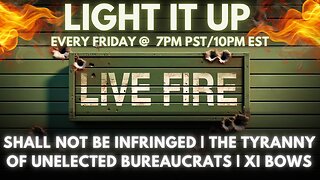Premium Only Content

3 vs 1 Street Fight - Self Defense
Get Your FREE Lethal Fight Enders Here ► https://fightfast.com/FightEnders
De-escalate the Situation: Try to calm the situation down by speaking in a soft, non-threatening tone. Avoid escalating the situation with aggressive body language or provocation. Communicate Clearly: Clearly communicate your desire not to engage in a fight. Sometimes, simply stating that you do not want any trouble can diffuse a tense situation. Remove Yourself from the Situation: If possible, leave the area to avoid further confrontation. This is often the safest and most effective way to prevent violence. Seek Help: Look for authorities or security personnel to intervene, or call the police if you feel threatened and believe that you're in danger. Self-Defense: In many jurisdictions, you are allowed to defend yourself if you are attacked and there is no possibility of retreat or de-escalation. However, the use of force must usually be proportional to the threat faced. Remember, every action you take in a conflict situation can have legal and personal consequences. It's crucial to prioritize non-violent solutions and understand the laws regarding self-defense in your area. If you're frequently finding yourself in situations where you feel threatened, it may be beneficial to seek out conflict resolution training or self-defense classes that emphasize de-escalation techniques. Stay Aware of Your Surroundings: Always be conscious of your environment and the people around you. Awareness is your first line of defense. Incorporating keywords like "awareness in self-defense" and "environmental awareness for personal safety" can attract attention. Use Your Voice: Loudly verbalizing your refusal or calling for help can deter attackers. Keywords like "verbal self-defense techniques" and "using your voice for protection" are searchable terms that highlight the importance of vocalization in self-defense. Master Basic Self-Defense Moves: Learn a few effective moves that can be used in various situations, such as how to free yourself from a grip or how to protect your vital areas. Keywords such as "effective self-defense moves" and "basic fighting techniques for safety" will likely draw in those looking to learn self-defense basics. Keep Your Distance: Maintaining a safe distance from an aggressor allows you more time to react. Phrases like "maintaining distance in self-defense" and "strategies to keep attackers at bay" are useful for SEO. Target Vulnerable Areas: Focus on striking areas where you can cause the most impact with the least amount of force, such as the eyes, nose, throat, and groin. Keywords like "vulnerable spots in self-defense" and "high-impact self-defense targets" are essential for engaging an audience seeking effective defense tactics. Use Everyday Items as Weapons: Teach how to use common items like keys, pens, or bags as improvised weapons. Keywords like "improvised weapons for self-defense" and "everyday items for personal protection" can capture interest. Practice Situational Self-Defense: Prepare for various scenarios, whether it's defending against multiple attackers or protecting yourself in confined spaces. Including terms like "situational self-defense strategies" and "self-defense in confined spaces" can enhance searchability. Enroll in a Self-Defense Class: Encourage continuous learning and practice by taking courses from professionals. Keywords such as "self-defense training" and "where to learn self-defense" can guide readers towards seeking formal education.
20% off ►http://threatresponsesolutions.com/YouTube
Did you know FightFast also sells tactical gear? ► https://catalog.trsdirect.com
FightFast Blog ► http://www.fightfast.com/blog
Facebook ► http://facebook.com/fightfast
Instagram @TRSsurvival ► https://instagram.com/trssurvival
#SelfDefense #TRSsurvival #FightFast
-
 3:43
3:43
FightFast
10 months agoThis Will BREAK BONES - Real World Self Defense
98 -
 1:08:40
1:08:40
IsaacButterfield
10 hours ago $17.11 earnedThis is Disgusting!! The Pope's Conspiracy and Kanye's Cousin Drama!
63.1K63 -
 3:40:59
3:40:59
FreshandFit
9 hours agoAfter Hours w/ Girls
119K53 -
 2:06:07
2:06:07
TimcastIRL
10 hours agoDemocrats LOSE IT Over SECOND Liberal Judge ARRESTED By Trump Admin | Timcast IRL
210K197 -
 1:26:16
1:26:16
Man in America
1 day agoEXPOSED: Trump's COVERT War Against the European Banking Cartel w/ Tom Luongo
97.7K45 -
 1:45:48
1:45:48
Glenn Greenwald
14 hours agoGlenn Reacts to News of the Week; Plus: Audience Q&A | SYSTEM UPDATE #443
112K83 -
 11:05:38
11:05:38
Dr Disrespect
19 hours ago🔴LIVE - DR DISRESPECT - PUBG - 5 CHICKEN DINNERS CHALLENGE
229K21 -
 3:23:12
3:23:12
I_Came_With_Fire_Podcast
18 hours agoSHALL NOT BE INFRINGED| THE TYRANNY OF UNELECTED BUREAUCRATS | XI BOWS
51.8K9 -
 4:19:36
4:19:36
SynthTrax & DJ Cheezus Livestreams
20 hours agoFriday Night Synthwave 80s 90s Electronica and more DJ MIX Livestream THE GREAT EDO WARS OF 2067 Edition
85.3K10 -
 4:45:15
4:45:15
RalliedLIVE
10 hours ago $1.85 earnedWarzone Domination w/ Ral
60.8K1